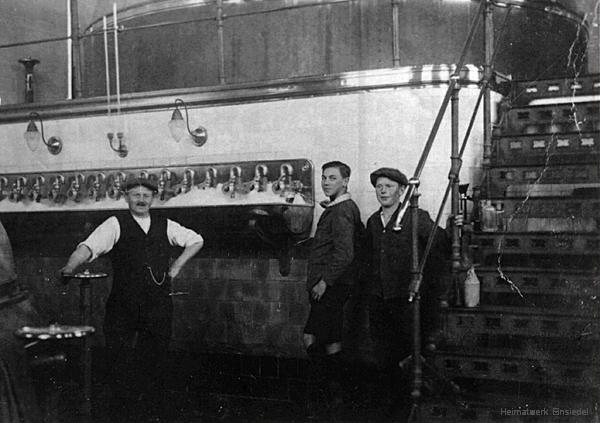Einsiedler Brauhaus – pictured history
Einsiedler Brauhaus GmbH is a midsize brewery located in Chemnitz, near the Czech border. It all started in 1885 when machinery industrial, Mr Emil Schwalbe, established the brewery in Einsiedel, near Chemnitz. During the 20th Century the brewery went through an eventful history. Einsiedel is a tiny place situated at the foot of the Ore mountains, part of the Bohemian massif, in the Free State of Saxony. The place Einsiedel was incorporated by Chemnitz in 1996.

In 1885 Emil Schwalbe had a luminous idea by purchasing a few local farms on the outskirts of Einsiedel that provided excellent well water. On that same location Emil Schwalbe started to build his brewery.
The newly built brewhouse (in the background the lauter tun) had a capacity 300 hl. The Brewhouse consisted 4 more parts (a mash tun, a mash pan, a lauter tun and a wort kettle) could produce 1200 hl daily.
The brewhouse was destroyed considerably at the end of WW II but rebuilt in the original style. We still brew in that same brewhouse today.

Before the Great War the brewery encountered severe difficulties to supply customers. The production peaked to 70,000 hl per annum before WW I. In Europe traditionally Beer from Breweries got delivered mainly in kegs to pubs and restaurants or to retailers. Back in the day these retailers had small bottle filling equipments where the beer was filled into flip top bottles and redistributed within the local communities.

At the beginning of the 20th Century the brewery owned 33 horses, 12 oxes and in 1912 came the first trucks. Despite these supply possibilities the fleet reached quickly its limits within our hilly area.
During WW I most of the workers were called to join the army. Later the brewery faced lots of problems to get supply of raw materials. After the Great War the production represented only half of its peak before WW I.
In the mid-1920 the brewery managed to recover. 109 coworkers helped producing 86,500 hl of beer in 1929. After the global economic recession in 1932 sales decreased once again. In 1937 only 37,000 hl of beer were sold.
In 1945 the brewery was severely destroyed by air strikes. Raw materials were hard to find. The annual production declined to 24,000 hl. The brewery was put under governmental administration and shortly after partly expropriated. In 1972 the brewery got fully integrated into the VEB Drink Collective Combine Karl-Marx-Stadt.

It lasted until 1959 when the production reached 100,000 hl again. In 1972 the brewery received strict instructions by the government to produce only bottled beer. The keg filler got dismantled. Since the Seventies of the 20th Century 200,000 hl of beer are being produced per annum on regular basis. In the Eighties the production climbed to 300,000 hl on yearly basis.
April 1990, after the fall of the GDR (aka East Germany) the brewery returned into private ownership. The daughter of the latest owner runs the business. Since the Summer of 1990 we brew again according to the Reinheitsgebot.

Almost the entire machinery was worn-out and is no longer inovative neither does it meet current technological requirements. The Brewhouse was from 1907, the fermentation tanks came from the same period of time and the keg filler didn’t exist anymore.
Therefore everything needed to comply with the latest state of the art. Step by step a brand new fully automatic Brewhouse replaced the former one into the old building. During the induction brewing we are now capable to produce up to 8 brews of 330 hl each per day. New fermentation tanks were purchased. The first 9 fermentation tanks had a capacity of 1200 hl each. Later we added more. In 1991 we bought a new keg filler.













